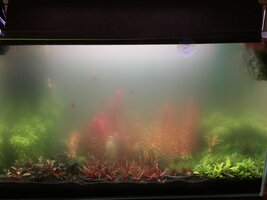That fluffy algae going out. With the help of some manual maintenance ( wafting my hand round plus paper towel in the skimmer to remove spores.) did that a couple weeks ago and seems to have helped. For a while thought the tank would completely clear out in terms of the column, but it seems to have come back a bit.
Oh well plants seem happy enough.
Tonina planting inspired by the one and only @Hufsa
Oh, and I actually haven’t done a water change since this whole bloom thing…. Those just seemed to make it worse last time!
Oh well plants seem happy enough.

Tonina planting inspired by the one and only @Hufsa
Oh, and I actually haven’t done a water change since this whole bloom thing…. Those just seemed to make it worse last time!




